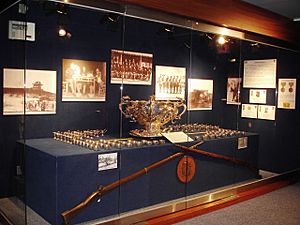Punch bowl facts for kids
A punch bowl is a large, wide bowl used for serving a drink called punch. These bowls are often decorative and have been used for centuries to share this popular beverage.
Contents
What is Punch and Where Did it Come From?
The word punch comes from the Hindi word paantsch, which means "five." This is because the original punch drink was made with five main ingredients:
- A spirit (like rum or brandy)
- Sugar
- Lemon
- Water or tea
- Spices
British sailors and workers from the British East India Company brought the drink from India to England in the early 1600s. From England, punch then became popular in other European countries.
All About Punch Bowls
Punch quickly became a very popular drink. It was served in special bowls, usually made from ceramic or silver. These bowls were often beautifully decorated.
Some punch bowls came with lids or were placed on a stand. They also often had matching accessories, like a serving ladle and small cups for drinking the punch. People sometimes painted messages on punch bowls. They were also given as special gifts to celebrate important events. For example, the first successful whaling trip from Liverpool was celebrated with a punch bowl given to the ship's captain.
In the 1800s, punch bowls were very common in many homes. They were often given as gifts, especially to newly married couples, rather than being bought.
Sometimes, people used very unusual containers as punch bowls! For example, in 1694, Admiral Edward Russell held a huge party in Spain. He turned a large marble fountain into a giant punch bowl! It held a massive amount of punch, made from:
- Four large barrels of brandy
- A barrel of wine
- Twenty gallons of lime juice
- Twenty-five hundred lemons
- Thirteen hundred pounds of sugar
- Five pounds of nutmeg
- Three hundred toasted biscuits
- Eight large barrels of water
A small boat was even built so a ship-boy could row around the fountain to help fill cups for the six thousand guests!
Famous Punch Bowls

Some punch bowls are very famous or have interesting stories:
- Jesus College Punch Bowl: Jesus College, Oxford in England owns a huge silver punch bowl. It was given to the college in 1732. This bowl weighs over 200 pounds and can hold 10 gallons of punch! It was used at a special dinner in 1814 to celebrate what people thought was the final defeat of Napoleon. Many important people attended, including the Tsar of Russia and the Duke of Wellington. There's a college tradition that if someone can put their arms around the bowl at its widest point (it's 5 feet wide!) and then drink all the punch, they get to keep it. So far, no one has managed to do both!
- The Stanley Cup: This famous trophy, given to the champions of ice hockey, is often described as looking like a punch bowl.
- Sydney Punchbowls: These are special Chinese porcelain bowls that show rare scenes of early Sydney, Australia.
- The Liscum Bowl: This set is made from 90 pounds of sterling silver. It was given to the United States Army by China in 1900 during the Boxer Rebellion. It is now the most valuable item owned by the 9th Infantry Regiment and is worth over $2.5 million.
Other Uses for Punch Bowls
Sometimes, punch bowls were used for other purposes. In some families that did not follow the main church, they were used as baptismal fonts for baptizing babies.
The American poet Oliver Wendell Holmes wrote a poem called On Lending a Punch-bowl about an old silver punch bowl.
Large, bowl-shaped areas in nature, like valleys or hollows, are sometimes named "punch bowl" because of their shape. Examples include the Devil's Punch Bowl in England and Punchbowl Crater in Hawaii.
See also
 In Spanish: Ponchera para niños
In Spanish: Ponchera para niños


